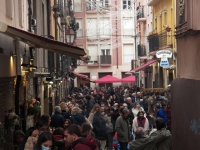Health
Spain returns to medium risk due to covid-19 after the increase in infections
The new Omicron variant worries
USPA NEWS -
After weeks of persistent drops in the number of infections and deaths from covid-19, which placed Spain at low risk, the country is once again at medium risk, with some of its territories at extreme risk. And this happens when health authorities try to assess the danger of a new variant of the coronavirus, coming from South Africa: the Omicron, which presents some thirty changes compared to the original and, according to experts, is much more contagious than its predecessors.
To date, Spain registers 5.13 million infections and 87,955 deaths from covid-19. With nearly 80 percent of the population vaccinated on the full schedule, the focus is now on children older than 5 years and on deniers who refuse to be vaccinated. Statistics say that nine out of ten new infections occur in unvaccinated people, which is why the Spanish Government is campaigning to remember that vaccines save lives. Catalonia, Madrid and Andalusia are the Spanish regions with the highest number of infections and deaths, which is partly explained by their larger population.
But, what explains the rebound in cases that has been registered in recent days? When the numbers of infected and deceased began to drop persistently, the Spanish health authorities affirmed that the pandemic had been controlled and that, with certain recommendations, the Spaniards could return to normality. Of course, with a mask in closed spaces or with large crowds of people and with the hygienic-sanitary measures that have been applied since the beginning of the pandemic.
A consequence of this are the images that, especially on weekends, are repeated in tourist areas: hundreds of people, without a mask and without keeping a safe distance, drinking and dancing without worrying about the risk that this activity entails. USPA News was able to verify this in one of the most famous streets in northern Spain to eat and drink: Laurel de Logroño street, the capital of the Rioja wine region. The hospitality entrepreneurs congratulate themselves on having recovered the pre-pandemic activity of their businesses and deny any responsibility for the possible health consequences of their customers' behavior.
This happens less than a month before Christmas. The Spanish Government and regional governments deny that they are going to enact restrictions such as those that were in force during the toughest moments of the pandemic, although several of them have ordered that a vaccination certificate be required from customers who want to access the interior of the local and even their territories. They are the ones with the worst figures at the moment: Galicia, Cantabria, the Basque Country, Navarra and Aragón. Other regions consult with their legal services the legality of the measure, with a view to implementing it in their territories.
Omicron
Meanwhile, attention is focused these days on the new variant of the coronavirus from South Africa. Named by the WHO as Omicron, the new variant seems to be more contagious and have a greater spread capacity than its predecessors, although some experts assure that it is not more lethal than other previous variants. It does seem proven that it has the highest number of mutations observed so far. The Omicron has been detected in Spain, but also in Belgium, Denmark and other European countries.
Because of this, the European Commission last week ordered the suspension of flights with South Africa. Countries like Spain went further and the Spanish Government announced the suspension of flights to and from South Africa, but also that it will require a complete vaccination certificate from travelers from the United Kingdom due to the special British relationship with its former colony.
Liability for this article lies with the author, who also holds the copyright. Editorial content from USPA may be quoted on other websites as long as the quote comprises no more than 5% of the entire text, is marked as such and the source is named (via hyperlink).






